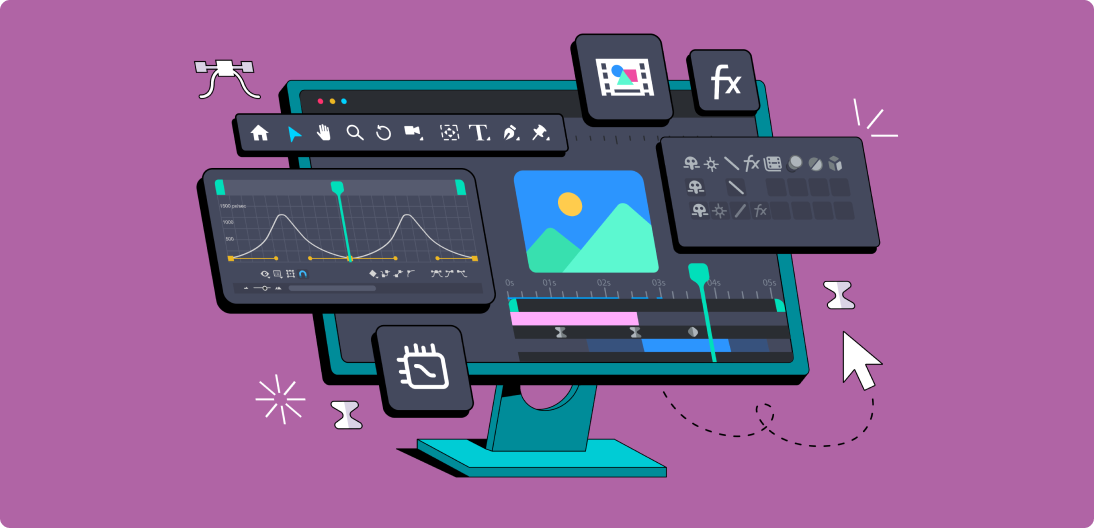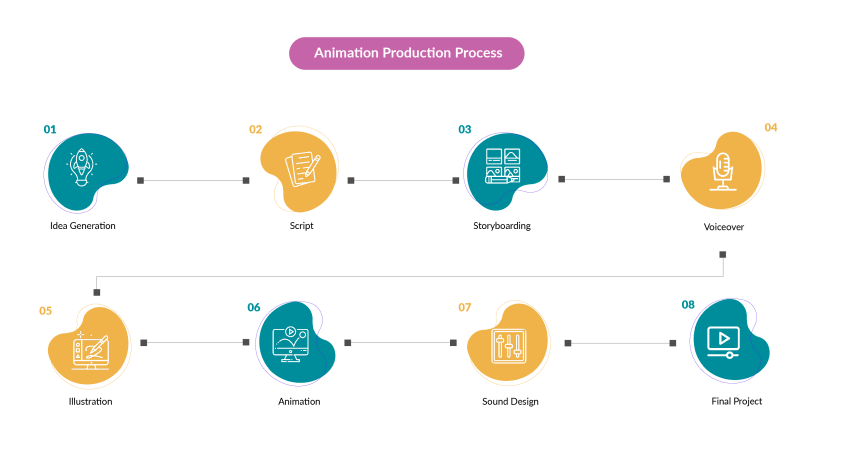Design Studio
Exploring the World of Video Animation
LantroTech Marketing
April 2, 2024

Video animation has revolutionized the way we perceive and interact with digital content. From captivating storytelling to engaging marketing campaigns, animation has become an indispensable tool across various industries. So, what is Animation? The process of altering still images to give the impression that they are moving is called animation. The repeated motion of still images at various frame rates produces the illusion. Since its beginnings, animation has advanced significantly. It has allowed people to narrate stories in the most captivating and significant ways.
We at LantroTech understand the importance of video animation services and know that no matter the audience’s age, one of the finest methods to hold their attention is through moving graphics also known as animated videos. Even though the design of the videos is captivating, it can be unclear how the various types of animation operate. In this blog, we will delve into exploring the world of video animation by examining its evolution, steps, types, applications, and future prospects.
The Evolution of Video Animation
Video animation has undergone a remarkable evolution over the decades, transitioning from traditional hand-drawn techniques to sophisticated computer-generated imagery (CGI) and beyond. This process has been driven by advancements in technology, changes in artistic styles, and the growing demand for visually captivating content across various industries. The field of animation has been around for a while. But before computers and digital tools revolutionized the film business, the method needed to bring characters and tales to life was very different. Films and short movies from that era were created entirely by hand, requiring years to finish a laborious and intricate procedure.
In hand-drawn animation, a transparent plastic sheet known as a “cel” is used to create each frame of a story consecutively. After that, each cel is captured on camera and quickly replayed to give the impression of motion. Because it required extremely talented workers and painstaking attention to detail, this animation production process was eventually supplanted by more contemporary methods like 2D and 3D animation.
Let’s take a journey through the key process and types of this fascinating evolution:
The Animation Process Used at LantroTech

It’s likely no secret that animated movies, such as explainer videos and whiteboard animations, make it easy and simple to communicate your company’s message—even if your product or service is really difficult to comprehend at first glance. You may be aware of the benefits of purchasing one of these videos, but you may not be as familiar with the details of the animation process itself. So, whether you’re on this new path alone or are thinking about getting the assistance of a video marketing company, let us explain to you the animation process we use at LantroTech.
All set? Now, let’s get started!
1. Idea Generation
Character design and script brainstorming are just two aspects of creating animated videos; the other important aspect is thoroughly understanding and researching your business. For this reason, we always take the time to learn as much as we can about your brand, product, and service to identify your unique needs and objectives for your animated video.
2. Script
What message do you want to convey with this video? The second animation process focuses on identifying the central idea of your work and crafting a coherent screenplay to convey it successfully and captivatingly. Regardless of how intricate the idea we’re working on is, we always create a straightforward script that is easy to read and helps your message come through.
3. Storyboard
The third step is crafting the storyboard. Essentially, your script’s visual representation can help organize your narrative. From now on, when you want to make an animation, you should depict the keyframes of your next film using a format similar to a comic book. In our instance, we offer a short description containing the essential script lines and any other pertinent information regarding how the tale will progress. Our production crew at Lantro’s design studio views the storyboard as the road map that will help them create a cohesive and captivating work for our clients. It’s one of the most important tools in our animation production workflow because it helps us avoid errors, inconsistencies, and needless delays in addition to enabling our clients to see and verify how the film will appear.
4. Voiceover Narration Recording
Choosing the right narrator to help the story come to life is crucial to the animation process. It’s important to use a voice that fits the tone of the video. It can be challenging to choose only one at this point in the animation production process, so we always recommend that you think about whether you want a more feminine or masculine voice before narrowing down your options and selecting your favorite.
5. Illustration
This stage can be done using computer software such as Illustrator or Adobe Photoshop. When employing digital tools for illustration, the animator uses the software’s many digital brushes to sketch their ideas for backgrounds and characters. They work directly on the canvas or on different layers, which makes it possible to make rapid edits and change or undo strokes with ease. To guarantee clarity and detail, the illustration is always produced at a high resolution. It is then exported in an appropriate file format, such as PSD and AI for layered files or PNG and JPG for single image files.
6. Animation
In this step, the skilled graphic designers at LantroTech set out to bring the illustrations to life. Using Illustrator or Adobe Photoshop, they import the illustrations and start rigging them. This implies that in order to generate the animation, they construct a kind of skeletal system that regulates the movement of each element of the artwork at particular times. Following that, they produce keyframes, which are, to put it simply, the frames that specify a character’s crucial positions or poses. Lastly, before exporting the animation into the appropriate file format, our team thoroughly examines it and looks for any discrepancies. In addition, they smooth out any frame flaws to provide a sleek, polished appearance. And that’s how an animation is made. It should come as no surprise that finishing this step of the animation production process can take some time, as it is one of the trickiest!
7. Sound Design
We edit and synchronize the music, sound effects, and voiceover recording with the visual equivalent in this step of the animation process. We take great care to produce the greatest animated video possible since we know how important the music and audio quality can be to the final product.
8. Final Project
Rendering is required for each and every digital element and frame in this step. This indicates that they will all be merged, per the artist’s wishes, into a single video file. You have complete control over the process, so you may specify the ideal resolution, aspect ratio, frame rate, and other factors based on the specifications of your project. For example, when producing videos for social media, where specific requirements must be met, this can be especially crucial. Apart from that, it’s crucial to remember that rendering is sometimes one of the longest stages of creating an animated video, especially when working with intricate sceneries or high-quality results. After that, this stage’s last animation step is completed. After that, this stage’s last animation step is completed. Careful editing in post-production enhances the animation. Here, you would use color correction methods and enhance the animation with any last details or effects to make it seem fantastic.
Types of Video Animation Used in LantroTech
Before making animated videos, it’s helpful to quickly review the various types of animation productions that are available. Because video animation can effectively engage, inform, and entertain audiences, it has become a standard component of marketing tactics. The following are some examples of common types of video animation used in marketing:
1. 2D Animation
Two dimensional animation is the most popular animation style in video marketing, it usually consists of flat characters and objects. It further includes Character Animation which involves creating animated characters to represent any brands, products, or services. These characters can help create emotional connections with the audience and make the marketing message more relatable. For example 2D Animation is used in movies, advertisements, promotion animation, etc.
2. 3D Animation
The items on the screen in a 3D animated video have depth in addition to height and breadth. In contrast to 2D animation, 3D objects and characters are digitally mesh-modeled rather than drawn. Product movies in this format are perfect for providing viewers with an immersive visual experience or revealing the inner workings of a mechanical product.
3. Typography Animation
Typography animation focuses on animating text to convey a message creatively. It involves adding movement, transitions, and effects to text elements to capture viewers’ attention and reinforce the marketing message.
4. Explainer Videos
Explainer videos are short animated videos that briefly explain a product, service, or concept. They typically use animation to simplify complex ideas, making them easier for viewers to understand.
5. Stop Motion Animation
Stop motion graphics involve capturing individual frames of a scene with physical objects and then sequencing them together to create motion. While less common in digital marketing, stop motion can add a unique and nostalgic appeal to promotional videos.
6. Interactive Videos
Interactive videos allow viewers to engage with the content by making choices or taking actions that influence the narrative. They provide a personalized and immersive experience, enhancing viewer engagement and retention.
Conclusion
Video animation continues to push the boundaries of creativity, innovation, and storytelling. Whether entertaining audiences, educating students, or driving marketing campaigns, animation has become a powerful medium with boundless possibilities. As technology advances and new mediums emerge, e.g., with the advancement of artificial intelligence and virtual reality, video animation is poised for more significant evolution and impact. In conclusion, the evolution of video animation has been a journey marked by innovation, creativity, and technological breakthroughs. From the humble beginnings of hand-drawn animation to the dazzling feats of computer-generated imagery, animation has captivated audiences worldwide and continues to inspire generations of artists and storytellers. As we embrace the future of animation, one thing remains sure that the magic of animation will continue to enchant and amaze audiences for years to come.
However, if crafting a stunning video animation feels overwhelming, fear not! At LantroTech, we specialize in delivering customized end-to-end video animation services. We tailor our services to suit your requirements and preferences, ensuring a seamless and engaging animation experience. To discover more about our Video Animation services and how they can elevate your digital presence, contact us today by completing the form below. Let’s bring your ideas to life through the magic of animation!